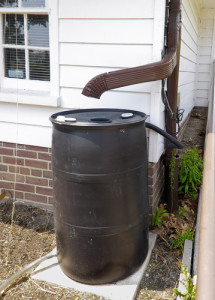 If you’re looking to save money on water for your household, consider collecting rainwater. Using rainwater has a lot of benefits, and rainwater collection systems are fairly simple to put together. Collecting rainwater also means that you are practicing more sustainable living.
If you’re looking to save money on water for your household, consider collecting rainwater. Using rainwater has a lot of benefits, and rainwater collection systems are fairly simple to put together. Collecting rainwater also means that you are practicing more sustainable living.
There are many reasons why using rainwater is advantageous. First of all, rainwater does not go through the complex filtration and treatment process. Directly collected rainfall typically has low hardness levels and does not pick up extra minerals, salt, and other pollutants from seeping into the ground, reducing stress on underground aquifers. Collecting rainwater tends to cut down on erosion and household water waste as well saving time and money.
Moreover, rainwater can be used for a wide variety of purposes including drinking, cooking, bathing, irrigation, watering plants, and watering and washing animals. Plants especially seem to enjoy the soft, warm, chlorine-free water. Stored rainwater can serve as a handy supply in case of emergencies and/or power outages.
The most basic method of collecting rainwater is that of a rain barrel. Simply place the barrel outside and wait for it to be filled with rain. In order to minimize the number of contaminants in the water, be sure to keep the barrel clean and free from debris. Remove any overhanging branches and debris in gutters. You can keep mosquitoes out and other insects out by making sure the barrel is sealed tightly and covered on top with a fine wire mesh. You’ll probably still need to boil the water before drinking to remove viruses, bacteria, and other parasites.
Another way to collect rainwater is through a rainwater harvesting system. Also known as a rainwater catchment system, this is a must if you plan to use rainwater as your household’s sole water source. Small systems cost a few thousand dollars, or you can fashion your own. A rainwater catchment connects your house’s gutters to a center water tank; some can hold up to 100,000 liters of water.
To fashion a rainwater harvesting system, make sure that your house is fitted with gutters or downspouts. If not, you can place aluminum or plastic on the rim of the house’s roof. The rain will fall on the roof and collect in the gutters. The downspouts will funnel the water downward; you can make your own from aluminum or plastic. Place a water container or rain barrels beneath the downspouts. The containers or rain barrels are placed on top of cinder blocks for stability.
Overall, rainwater is not hard to collect, and it has a lot of advantages for use in your household. When you harvest rainwater, you cut down on water waste and improve the environment at the same time.

2 comments
You need to add if it is legal in your state. Mine you CAN NOT collect rain water, ask me how I know this. I was told to take it down in 2 days or face a fine. They came back with the county sheriff to look if I took it down. There are several more states that are the same way.
I would think that with a little ‘Creative thinking’ that rain water could be diverted to a basement or an attic. At least have the items needed when the time comes when you have to have water and there may not be anyone around to tell you ‘No’ Build a back yard shed with a gutter system that diverts 1/2 of the water inside.